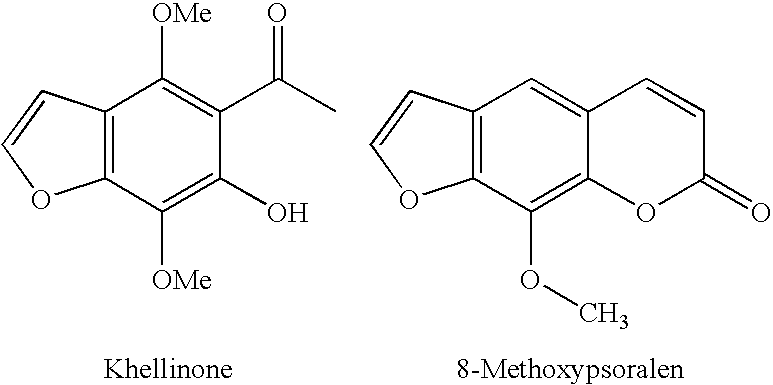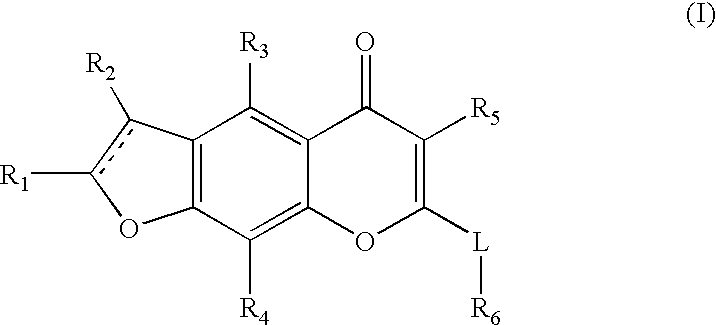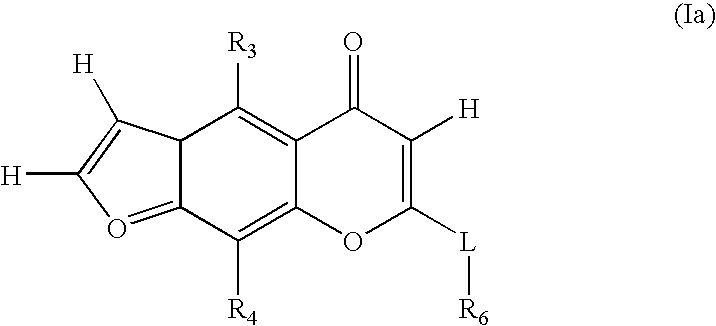Novel chromenone potassium channel blockers and uses thereof
a potassium channel blocker and chromenone technology, applied in the field of compounds, can solve the problems of increased medical care costs and income loss, inflammation and scarring, damage to blood vessels,
- Summary
- Abstract
- Description
- Claims
- Application Information
AI Technical Summary
Benefits of technology
Problems solved by technology
Method used
Image
Examples
example 1
[0151]
a) 4,7-Dimethyl-9-(3-(phenyl)propoxy)-5H-furo[3,2-g]chromen-5-one
[0152]7-methyl-9-(3-phenylpropoxy)-4-hydroxyl-5H-furo[3,2-g]chromen-5-one (8.0 g, 22.9 mmol) was reacted according to General Procedure D (Step 1) to provide the corresponding triflate derivative (10.2 g, 92%). The triflate (10.2 g, 21.1 mmol), ZnBr2.2H2O (18.65 g, 71.4 mmol), CuI (200 mg, 1.05 mmol), PdCl2(PPh3)2 (400 mg, 0.56 mmol) and MeLi (44.6 mL of 1.6 M in diethylether, 71.4 mmol) were reacted according to General Procedure D (Step 2) and the crude material was purified by silica-gel flash chromatography, eluting with dichloromethane to afford the title compound as a white solid (7.1 g, 97%). 1H NMR (300 MHz, CDCl3): δ 2.08-2.18 (m, 2H), 2.36 (s, 3H, Me), 2.92 (t, J=7.6 Hz, 2H Hz, CH2), 2.96 (s, 3H), 4.39 (t, J=6.3 Hz, CH2), 6.05 (s, 1H), 6.92 (d, J=2.1 Hz, 1H), 7.16-7.34 (m, 5H), 7.64 (d, J=2.1 Hz, 1H). MS (ES+) m / z: 348.9 (M+H+).
b) 5-Acetyl-6-hydroxy-4-methyl-7-(3-(phenyl)propoxy)benzofuran
[0153]Example ...
example 2
[0156]
7-Dimethylaminomethyl-4-methyl-9-(3-phenylpropoxy)furo[3,2-g]chromen-5-one
[0157]To a solution of Example 1b) (500 mg, 1.54 mmol) and N,N-dimethylglycine ethyl ester (0.44 mL, 3.12 mmol) were reacted according to General Procedure C. The crude residue was subjected to flash chromatography, eluting with dichloromethane:ethyl acetate (1:1 then 1:3) and the material thus obtained was dissolved in ethyl acetate and washed with water (4×) and brine to remove traces of excess N,N-dimethylglycine ethyl ester. The organic layer was dried over MgSO4 and concentrated in vacuo to afford the title compound as a clear resin that crystallised on standing overnight (215 mg, 36%). 1H NMR (300 MHz, CDCl3): δ 2.09-2.18 (m, 2H), 2.36 (s, 6H), 2.91 (t, J=7.4 Hz, 2H), 2.96 (s, 3H), 3.43 (s, 2H), 4.40 (t, J=6.3 Hz, 2H), 6.26 (s, 1H), 6.92 (d, J=2.3 Hz, 1H), 7.16-7.30 (m, 5H), 7.64 (d, J=2.3 Hz, 1H). MS (ES+) m / z 391.9 (M+H+).
example 3
[0158]
4-Methyl-7-(morpholin-4-ylmethyl)-9-(3-phenylpropoxy)furo[3,2-g]chromen-5-one
[0159]A solution of Example 1c) (200 mg, 0.50 mmol) in dichloromethane (1 mL) was treated with iodomethane (2 mL, excess) and heated at reflux for 3 days. During this time a white precipitate formed. The reaction was cooled, filtered and the filtrate concentrated in vacuo to yield the crude iodide product as a tan solid contaminated with ˜30% starting material (230 mg total mass). This crude material was used in subsequent reactions without further purification. To a solution of the crude iodide (40 mg) in dry dichloromethane (1.5 mL) was added morpholine (2 drops from a pasteur pipette) and the mixture was stirred at rt for 1 h. After this time the reaction was diluted with dichloromethane (20 mL) and washed with water (20 mL) then brine (10 mL), dried over MgSO4 and concentrated in vacuo. The crude residue was purified by flash chromatography, eluting with dichloromethane:ethyl acetate (2:1, 1:1 the...
PUM
 Login to View More
Login to View More Abstract
Description
Claims
Application Information
 Login to View More
Login to View More - R&D
- Intellectual Property
- Life Sciences
- Materials
- Tech Scout
- Unparalleled Data Quality
- Higher Quality Content
- 60% Fewer Hallucinations
Browse by: Latest US Patents, China's latest patents, Technical Efficacy Thesaurus, Application Domain, Technology Topic, Popular Technical Reports.
© 2025 PatSnap. All rights reserved.Legal|Privacy policy|Modern Slavery Act Transparency Statement|Sitemap|About US| Contact US: help@patsnap.com



